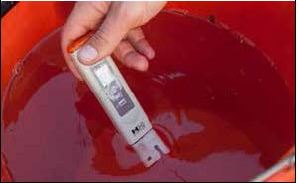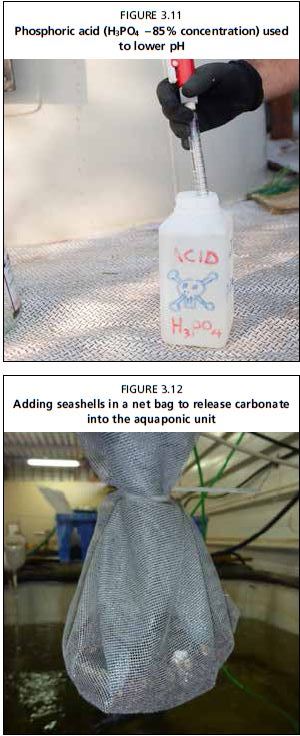3.5 MANIPULATING PH
There are simple methods to manipulate the pH in aquaponic units. In regions with limestone or chalk bedrock, the natural water is often hard with high pH. Therefore, periodic acid additions may be necessary to lower the pH. In regions with volcanic bedrock, the natural water will often be soft, with very low alkalinity, indicating a need to periodically add a base or a carbonate buffer to the water to counteract the natural acidification of the aquaponic unit. Base and buffer additions are also required for rainfed systems.
3.5.1 Lowering pH with acid
Aquaponic water naturally acidifies because of nitrification and respiration. With patience, the pH levels often decrease to the target range.
However, adding acid may be necessary if the source water has a high KH and high pH, and there is a high evaporation rate. In these uncommon and exceptional cases, the volume of water to resupply the system is such that it significantly raises the pH above the optimal ranges and overpowers the natural acidification. Adding acid is also necessary if the amount of fish stocked is not sufficient to produce enough dissolved wastes to drive nitrification and the resulting acidification. In these cases, the resupply of water will result in a resupply of the buffering agents, carbonates. The natural acid production will not be sufficient to react with the buffering agents and subsequently lower pH. Only add acid if the source water is very hard and basic and if there is not rainwater that can supply the system with KH-free water to help nitrifying bacteria to naturally lower the pH.
Adding acid to an aquaponics system is dangerous. The danger is that at first the acid reacts with buffers and no pH change is noticed. More and more acid is added with no pH change, until finally all of the buffers have reacted and the pH drops drastically, often resulting in a terrible and stressful shock to the system. It is better practice, if necessary to add acid, to treat a reservoir of this resupply water with acid, and then add the treated water to the system (Figure 3.10). This removes the risk to the system if too much acid is used. The acid should always be added to a volume of resupply water, and extreme care should be used not to add too much acid to the system. If the system is designed with an automatic water supply line it may be necessary to add acid directly to the system, but the danger is increased.
Phosphoric acid (H3PO4) can be used to lower the pH. Phosphoric acid is a relatively mild acid. It can be found in food-grade quality from hydroponic or agricultural supply stores under various trade names. Phosphorus is an important macronutrient for plants, but overuse of phosphoric acid can lead to toxic concentration of phosphorous in the system. In situations with extremely hard and basic source water

FIGURE 3.10
Checking the pH level in water using a digital meter

FIGURE 3.11 Phosphoric acid (H3PO4 -85% concentration) used to lower pH
ACID
FIGURE 3.12
(high KH, high pH), sulphuric acid (H2SO4) has been used.
However, owing to its high corrosiveness and even higher level of danger, its use is not recommended to beginners. Nitric acid (HNO3) has also been used as a relatively neutral acid. Citric acid, while tempting to use, is antimicrobial and can kill the bacteria in the biofilter; citric acid should not be used.
Concentrated acids are dangerous, both to the system and to the operator. Proper safety precautions should be used, including safety goggles and gloves (Figure 3.11). Never add water to acid, always add acid to water.
3.5.2 Increasing pH with buffers or bases
If the pH level drops below 6.0, it is necessary to add a base and/or increase carbonate hardness. Commonly used bases are potassium hydroxide (KOH) and calcium hydroxide (Ca(OH)2). These bases are strong, and should be added in the same way as acids; always change pH slowly. However, a safer and easier solution is
Adding seashells in a net bag to release carbonate to add calcium carbonate (CaCO3) or potassium into the aquaponic unit
carbonate (K2CO3), which will increase both the KH and pH. There are many natural and inexpensive sources of calcium carbonate that can be added to the system. Some of these include crushed eggshells, finely crushed seashells, coarse limestone grit and crushed chalk. The recommended method is to put the material in a porous bag suspended in the sump tank (Figure 3.12). Continue testing pH over the next few weeks to monitor the increase in pH. Remove the bag if the pH increases above 7. Alternatively, add 2-3 handfuls of these materials per 1 000 litres either straight into the media beds or biofilter component. If using seashells, be sure to rinse away residual salt before adding to the system. The choice of the bases and buffers can also be driven by the type of plants growing in the system, as each of these compounds adds an important macronutrient. Leafy vegetables can be favoured by calcium bases to avoid tip burns on leaves; while potassium is optimal in fruit plants to favour flowering, fruit settings and optimal ripening.
Sodium bicarbonate (baking soda) is often used to increase carbonate hardness in RASS, but should never be used in aquaponics because of the resulting increase in sodium, which is detrimental to the plants.